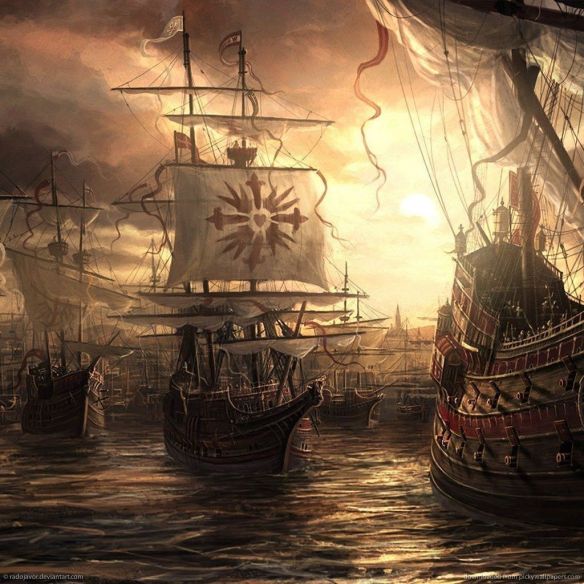In contrast, the English fleet stayed at the half-ready over the winter with most crew ashore and thus with ship’s stores intact. Its sailors were men and boys who had grown up to the sea and knew their home waters. Also, where the Spanish fleet took 20,000 marines onboard, expecting an infantry battle at sea, English ships had only a few dozen sharpshooters each. The English plan was to stand off and use long-range ship smashers, not grapple and fight in galley-fashion as the Spanish, with a long history of Mediterranean naval warfare, intended. Yet, even the English would be surprised at what actually happened when the battle fleets met in the Channel. Never before, and never again until the great carrier battles of World War II, had so many warships put to sea with so little knowledge of their own or their enemy’s real capabilities. It was, after all, the first fleet-to-fleet battle of the ‘‘Age of Fighting Sail.’’
The Armada sailed by national contingent: 10 galleons of Castile paralleled by 10 more from Portugal; next came 4 galleasses from Naples; then 40 armed merchants in squadrons of 10; plus 34 small and fast ships to serve as couriers, scouts, and dispatch carriers. Bringing up the rear were 23 hulks and 4 galleys. Flitting and darting among the larger ships were a squadron of zabras and pataches. All together 143 ships, 8,000 sailors, and 20,000 soldiers, among them 12,000 raw recruits, moved out of the harbor that fine May day. Sidonia had salted renegade English and Dutch pilots into each squadron to guide his captains through unknown Channel waters, but his crews were mostly green and lacked seamanship. It thus took 13 days for the Armada to move just 150 miles up the Portuguese coast. Then the crews were sorely tested by a great storm. When it was over it took Sidonia four days just to find and gather his ships and another month to repair them. The Armada did not set out again until July 21.
The English commander waiting to meet it was Admiral Lord Howard of Effingham. His top captains were all once and future privateers: John Hawkyns, Francis Drake, and Martin Frobisher. They set sail with Elizabeth’s fleet on July 29. The next night, Saturday, having weathered a second storm in which four galleys were lost along with another ship, the Armada moved into the Channel. It was spotted from shore and beacon fires lighted. Quickly, a line of fires hopscotched from hilltop to hilltop until the entire south coast of England was awake and warned from Plymouth to Dover. A second string of signal fires raced inland faster than man or horse or ship, to London, York, and as far north as Durham. The queen and militia were alerted and England readied to repel invasion.
From the moment the Spanish entered the Channel they lost the weather gauge, as English ships pulled in behind them out of Bristol and Portsmouth. Because winds held steady westerly for the next nine days, the English kept the wind advantage throughout. Moreover, the best English galleons were race-built and had skilled crews while too many Spanish ships were ponderous, leaky hulks or crewed by inexperienced sailors. Unable to outrun his more agile pursuers, Sidonia formed a great crescent with his strongest fighting ships at the tips to ward off the English and protect his weakest and slowest ships at the center. Howard and his captains followed at a distance while much of England gather at the coast to watch the fleets slowly pass. If the English were astonished at the size of the Armada the Spanish wondered at the speed and handling of the English race-built galleons, and at their number. No one had seen fleets like these before. This was something entirely new in the world: great battle fleets of Fighting Sail. Although no one knew it then, these ships and their descendants would dominate war at sea for the next 300 years, until the advent of steam and armor plate.
The first battle in modern naval history, fought by broadside navies, began on July 31, 1588, with an old chivalric gesture: an exchange of defiant notes delivered by each admiral’s pinnace (ship’s boat). Howard then formed a line astern and moved to attack the north tip of the Spanish crescent while Drake and Hawkyns attacked the southern wing. Each side’s tactics failed. Sidonia wanted to force a meˆle´e in which his ships would close and grapple and his marines overmatch the English. But even his best ships were not fast or handy as the enemy, so he was forced instead to hold formation and crawl northeast at one or two knots per hour. Howard wanted to stand off and hammer away with his long-range ship-smashers, a tactic never before used in a fleet-to-fleet action at sea, to avoid tangling with Spanish boarders and thousands of shipboard marines. English long-range gunnery was accurate, scoring many hits, but to Howard’s surprise his great culverins did not fire or sink any enemy ships. He moved his line in to 300 yards range to pound away some more. English gunners were again faster and more accurate than the Spanish, partly due to a difference in gun carriages. Hundreds of Spaniards died and Spanish sails flapped uselessly in the wind as rigging and spars were shot away at close range. Still without sinking one of Sidonia’s ships, Howard finally turned away at 1:00 P.M. Sidonia immediately broke the tips off his defensive crescent and sent his best warships in columns after the fast-fading English. Howard simply outran them, refusing to close for boarding actions with ships that overmatched his in upper deck small arms firepower and the number of their marines. After three hours the Spanish gave up, turning back north to rejoin the crescent that became their signature formation. That ended the first day.
